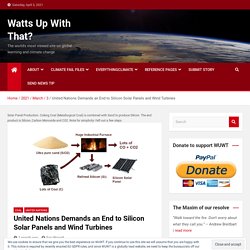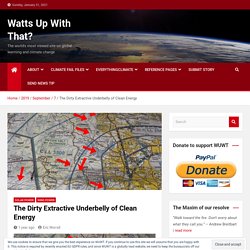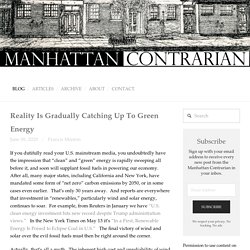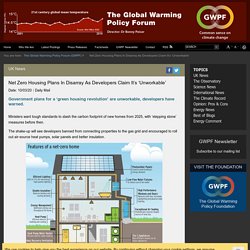

United Nations Demands an End to Silicon Solar Panels and Wind Turbines – Watts Up With That? Guest essay by Eric Worrall.

Bill Gates’s New Book Proposes Extreme Ways to Avoid a Climate Disaster, but at What Cost? “In a typical year the world emits over 51 billion tons of greenhouse gases, and as we keep doing that, the consequences for human life will be catastrophic.”

So begins the promotional video for Bill Gates’s new book, How to Avoid a Climate Disaster. Banning ICE Vehicles.
Net Zero in the US and Canada. Net Zero in Australia. 100% Solar. Decarbonising Energy. Brief Details How The ‘Green New Deal’ Would Be An Environmental Disaster. By Tim Benson Massive Plan Would Cause Serious Environmental And Ecological Harm A new Heartland Institute Policy Brief warns that the implementation of the “Green New Deal” (GND), introduced by Rep.

Alexandria Ocasio-Cortez (D-NY) and championed by other leading members of the Democratic Party, would cause serious environmental and ecological harm. This is primarily due to the massive land use of “renewable” energy sources such as wind and solar power and the amount of rare earth minerals that would need to be mined to manufacture these energy sources. The Brief, authored by Paul Driessen, a policy advisor to the Committee for a Constructive Tomorrow, notes that the GND has already been “roundly criticized for the astronomical costs it would impose upon factories, businesses, households, hospitals, and virtually every other sector of the U.S. economy, as well as for the economic devastation it would inflict.”
The Dirty Extractive Underbelly of Clean Energy. Guest essay by Eric Worrall Greens advocating a clean energy “revolution” rarely pause to consider the enormous increase in mining activity which would have to occur to support their new green economy.

The Limits of Clean EnergyIf the world isn’t careful, renewable energy could become as destructive as fossil fuels.BY JASON HICKEL | SEPTEMBER 6, 2019, 8:51 AM…We need a rapid transition to renewables, yes—but scientists warn that we can’t keep growing energy use at existing rates. No energy is innocent. The only truly clean energy is less energy.In 2017, the World Bank released a little-noticed report that offered the first comprehensive look at this question. Why 100% Renewable Energy Is Less Realistic Than a Unicorn. Guest “you can’t get there from here” by David Middleton The paper, published in Joule, was discussed in this August 8 WUWT post.

This article provides a little more detail. In order for wind & solar to actually be competitive, energy storage costs would have to drop to: $10-20/kWh to be competitive with nuclear power for baseload.$5/kWh to be competitive with natural gas peaker power plants. Nuclear power and natural gas peakers (CT) are the two most expensive dispatchable electricity generation sources, after than coal with CCS. Why don’t these lives matter? Child labor, human rights abuses and deaths are routinely ignored by Greens and Democrats Paul Driessen Marathon Petroleum recently announced it will “indefinitely idle” its Martinez Refinery.

The decision will remove hundreds of jobs, billions of dollars, and nearly 7 million gallons of gasoline, diesel and other petroleum liquids per day from the energy-hungry California economy. It will also send fuel prices even higher for minority and other poor families that already pay by far the highest gasoline prices in the continental United States: $1.32 more per gallon of regular than in Louisiana and Texas. Reality Is Gradually Catching Up To Green Energy. If you dutifully read your U.S. mainstream media, you undoubtedly have the impression that “clean” and “green” energy is rapidly sweeping all before it, and soon will supplant fossil fuels in powering our economy.

After all, many major states, including California and New York, have mandated some form of “net zero” carbon emissions by 2050, or in some cases even earlier. That’s only 30 years away. And reports are everywhere that investment in “renewables,” particularly wind and solar energy, continues to soar. For example, from Reuters in January we have “U.S. clean energy investment hits new record despite Trump administration views.” Net Zero Housing Plans In Disarray As Developers Claim It's 'Unworkable' Government plans for a ‘green housing revolution’ are unworkable, developers have warned.

Ministers want tough standards to slash the carbon footprint of new homes from 2025, with ‘stepping stone’ measures before then. The shake-up will see developers banned from connecting properties to the gas grid and encouraged to roll out air-source heat pumps, solar panels and better insulation. But housing bosses believe a deadline for the first changes this year is unrealistic because the UK lacks the workforce and enough heat pumps. Can we go back to the pre-fossil fuel era? Seems like an easy yes or no answer, but there are numerous financial costs and social change ramifications of going Green that make the answer weighty.

If everyone can recall history, the worlds already experienced life without fossil fuels just a few short centuries ago. 41 Inconvenient Truths on the "New Energy Economy" A week doesn’t pass without a mayor, governor, policymaker or pundit joining the rush to demand, or predict, an energy future that is entirely based on wind/solar and batteries, freed from the “burden” of the hydrocarbons that have fueled societies for centuries.

Excess costs of UK Weather Dependent Renewable Energy: 2018. Reposted from edmhdotme Summary: 2018 using Renewable Energy Foundation data In 2018 UK Weather dependent renewables generated some 7.7 Gigawatts of power from an installed fleet of ~34 Gigawatts achieving a satisfactory overall capacity factor for Renewables of ~23%. The installed fleet cost ~84£billion in capital costs with average costs of ~11£billion/Gigawatt produced in capital costs and ~42£billion/Gigawatt produced long-term. Because of the comparative capacity factors Offshore wind and Solar PV were roughly equivalent in capital costs at ~15£billion / Gigawatt produced and ~60£billion / Gigawatt produced over the long-term.
The direct comparison in the UK situation with similar measures for traditional generation technologies, Gas-firing and Nuclear, can be seen to be substantially lower above. This post gives indicative cost estimates of the current 2018 UK fleet of Weather Dependent Renewables, assuming no further growth, as both capital and probable long-term expenditures. The World Is Not Going To Halve Carbon Emissions By 2030, So Now What? Last year, the Intergovernmental Panel on Climate Change (IPCC) reported that “limiting global warming to 1.5°C would require rapid, far-reaching and unprecedented changes in all aspects of society.” Specifically, “Global net human-caused emissions of carbon dioxide (CO2) would need to fall by about 45 percent from 2010 levels by 2030, reaching ‘net zero’ around 2050.”
Since then, many advocates and policy makers have proposed that target as a political goal. Here I’ll show you the simple mathematics of what achieving the 2030 target entails. The evidence shows clearly that the world is far from being on a path that will come anywhere close to that goal. Why today’s renewables cannot power modern civilization. By Dr. Lars Schernikau Dr. Lars Schernikau has founded, worked, and advised many organizations in the energy, raw material, and coal sectors in Asia, Europe, Africa and the Americas. Lars finished his PhD on the economics of energy, commodities, and the global coal business and published two industry trade books (Springer, available on Amazon) in 2010 and 2017. Summary.
Net-Zero CO2 Emissions By 2050 Requires A New Nuclear Power Plant Every Day. What makes achieving Net Zero by 2050 impossible is a failure to accurately understand the scale of the challenge and the absence of policy proposals that match that scale. More than a decade ago, Gwyn Prins and Steve Rayner characterized climate policy as an “auction of promises” in which politicians “vied to outbid each other with proposed emissions targets that were simply not achievable.” For instance, among Democrats competing for the presidency in 2020, several, including Joe Biden, have committed to achieving net-zero carbon dioxide emissions by 2050. Net-Zero Carbon Dioxide Emissions By 2050 Requires A New Nuclear Power Plant Every Day. More than a decade ago, Gwyn Prins and Steve Rayner characterized climate policy as an “auction of promises” in which politicians “vied to outbid each other with proposed emissions targets that were simply not achievable.”
For instance, among Democrats competing for the presidency in 2020, several, including Joe Biden, have committed to achieving net-zero carbon dioxide emissions by 2050. Candidate Andrew Yang bid 2049, and Cory Booker topped that by offering 2045. How Much Power Will Be Wasted In A Low Carbon World? Natascha Engel: Net-Zero Carbon Target Is Reckless And Unrealistic. The Disastrous Economics Of Trying To Power An Electrical Grid With 100% Intermittent Renewables. The following article originally appeared (in slightly different form) as a portion of a comment submitted by the Concerned Household Electricity Consumers Council to the EPA in February 2018 with respect to EPA’s proposal to rescind an Obama-era regulation called the Clean Power Plan.
The effort to increase the percentage of electricity generated by intermittent renewable sources like wind and solar inevitably brings about large increases in the actual price of electricity that must be paid by consumers. The price increases grow and accelerate as the percentage of electricity generated from the intermittent renewables increases toward 100 percent. These statements may seem counterintuitive, given that the cost of fuel for wind and solar generation is zero.
Study: 100% renewables doesn’t equal zero-carbon energy. Ambrose Evans-Pritchard’s £1 Trillion Delusion. The cost of this net zero madness? Even a trillion is an underestimate. THE £1trillion figure is propaganda, not analysis; you can pluck any number you want.’ So said Adair Turner, the former head of the Committee on Climate Change (CCC), according to the Telegraph on Wednesday. Turner was lambasting Whitehall estimates of the cost of taking the country to net zero carbon emissions by 2050. Bjørn Lomborg: No, renewables are not taking over the world. New IPCC error: renewables report conclusion was dictated by Greenpeace – Mark Lynas. STOP PRESS – See 17 June update: ‘Questions the IPCC must urgently answer‘… The headlines were unequivocal when the IPCC renewables report came out a few weeks ago. Here’s the first line of the BBC News piece: Renewable technologies could supply 80% of the world’s energy needs by mid-century, says the Intergovernmental Panel on Climate Change (IPCC).
Study: Avoiding blackouts with 100% renewable energy. How 139 countries could be powered by 100 percent wind, water, and solar energy by 2050. Are Studies of High Penetrations of Wind Power Valid? GWPF Statement On The Proposed Net Zero 2050 Emissions Target. Summary The recommendation of the Committee on Climate Change (CCC) for a Net Zero emissions target by 2050 is grounded in nothing stronger than irresponsible optimism and arbitrary assumptions about cost and technological feasibility.